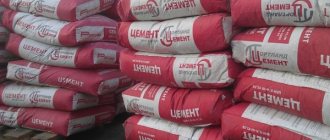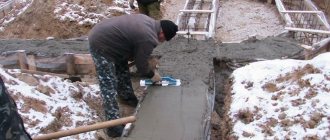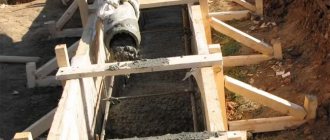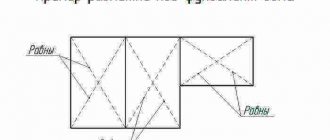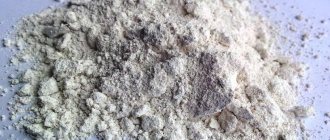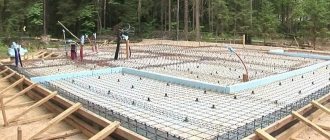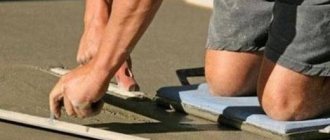When constructing a facility, you need to calculate in advance the amount of basic materials. This is especially important if the volume of work is large. To prepare the concrete mixture you will need: cement, crushed stone, sand and water.
In construction stores, binders are sold in bags of 25 and 50 kg. To purchase the required amount of material, calculate how much concrete will be made from 50 kg of cement.
Filling materials: sand and granite
Universal auxiliary components, interacting with cement, make it possible to obtain a durable building. Regardless of the brand and type of dry product, the composition of the concrete mass includes:
- crushed stone is a durable frost-resistant stone without harmful impurities and components. To increase the hardness of the concrete mixture, granite is used, with fractions from 10 to 40 mm. Good performance properties determine the high cost and popularity of the building material.
- Sand is a sedimentary solid. A correctly selected brand of sand helps reduce the consumption of expensive limestone. For foundations, alluvial quarry sand of medium grain size from 1.2 mm to 3.5 mm is in demand. The permissible amount of impurities should not exceed 5% of the total volume of sand.
Water is added to the solution in portions until a mixture of homogeneous consistency is obtained. When mixing the constituent elements, be sure to correctly determine their proportions. The resulting voids between grains of gravel if filled incorrectly will subject the base to rapid deformation.
What does consumption depend on?
The main requirement for concrete is to achieve the required strength after hardening. Based on this, in accordance with construction standards describing the quality of components, their ratio and technical characteristics are selected. This is done taking into account the strength grade of the composition; the recommended ratio of ingredients is indicated in specialized reference books. To calculate how much cement will be contained in 1 m³ of concrete, the following factors are taken into account:
- brand, density, required setting time;
- plasticity of the solution and its mobility;
- type of sand, fraction, presence of impurities, the proportion of which does not exceed 15%, otherwise this filler is subjected to pre-treatment - sifting or washing;
- fraction, type and other technical characteristics of crushed stone - flakiness, density, contamination, if it exceeds the norm, the crushed stone is cleaned;
- the presence of additional components that improve characteristics - hardeners or plasticizers.
During production, the brand of Portland cement is taken into account. It should be twice the grade of the composition made from it - for the M200 solution, take the M400 composition. The higher the brand, the less it will be needed to prepare the mixture of the required class.
How to calculate cement for a foundation
The method for calculating the required amount of cement is quite simple. The main role, naturally, is given to concrete, which is planned to be obtained from this building material. Having studied the proportions of concrete for the foundation, it is easy to calculate how much cement will be needed to build the foundation of the house. Calculations are usually carried out in bags that can contain kg of binder.
Approximately how much cement will be needed to build a foundation?
The calculation sequence can be presented as follows, step by step:
- First, we calculate the volume of concrete that will be used to build the foundation. We wrote how to do this in the article “Calculation of concrete for a foundation.” At this stage, it all comes down to summing up the volumes of individual foundation structures, or the usual volume calculation, which is important for a slab foundation;
- Next, we determine the composition of the concrete mass. Depending on the loads on the sub-foundation of the house, as well as the composition of the soil, the grade of concrete is determined. The percentage of cement per unit volume (usually calculated per cubic meter) depends on the brand of concrete mixture. At the same time, an analysis is carried out to determine whether it is necessary to introduce various additives into concrete to simplify the work under specific conditions;
- at the last stage, the required amount of binder and fillers (sand, crushed stone, etc.) is calculated. We will talk about what kind of sand is needed for the foundation in one of the following articles.
Below we have presented a table, using which you can calculate the approximate number of bags of cement per concrete for the foundation. Minor adjustments are possible both up and down. If you plan to strengthen the foundations with cementation (we are mostly talking about restoring the old foundation, when a new one is additionally attached to it), then, accordingly, the volume of required cement must be adjusted to the cement mortar, and not the concrete mixture.
Design grade of concrete Brand of cement used Approximate mass of cement per 1 cubic meter. m of concrete Number of bags 50 kg per 1 cubic meter m. concrete, pcs.
| M150 | M300 | 260 | 5,2 |
| M200 | M300 | 290 | 5,8 |
| M400 | 250 | 5 | |
| M500 | 220 | 5,4 | |
| M250 | M300 | 340 | 6,8 |
| M400 | 300 | 6 | |
| M500 | 250 | 5 | |
| M300 | M400 | 350 | 7 |
| M500 | 300 | 6 | |
| M400 | M400 | 400 | 8 |
| M500 | 330 | 6,6 |
It turns out that calculating the volume of cement for the foundation is not particularly difficult
It is only important to know the volume of concrete required for the construction of a specific type of house foundation, as well as the ratio of the components included in the concrete mixture
Purchase of high-quality building materials from Bauff
By contacting us, you can not only read a lot of useful articles on the site, but also acquire the required amount of high-quality cement. Working with the company is beneficial for a number of reasons:
- supply of certified goods from leading manufacturers;
- lack of mediation in resolving financial issues;
- constant availability of the products you need;
- delivery throughout Moscow and the Moscow region on individual terms;
- unquestioning compliance with warranty obligations, etc.
Carefully study the catalog and synchronize the information from the blog with your own needs and available products. You can also count on technical support from competent company representatives. They will notify you in a timely manner about the availability of goods from your order, help you pay for your purchases in the most convenient way, and then receive them at the address agreed upon in advance in the shortest possible time. We wish you success!
Approximate tabular data
The approximate consumption of cement per cube of concrete for the foundation, depending on the brand used, is presented in the tables:
mixture prepared on the basis of M300
| Concrete grade | M250 | M300 |
| Required mass of cement, kg | 340 | 300 |
based on M400
| Concrete grade | M300 | M400 |
| Required mass of cement, kg | 350 | 300 |
When the amount of cement of a particular brand in the composition changes, the brand of concrete changes. The values indicated in the table depend on the quality of the soil and the size of the crushed stone material, and therefore may change up or down during calculations.
Does it make sense to use M500 for the foundation?
Using the arithmetic method or tables, it is not difficult to find out, for example, how much M 500 cement is needed per 1 cubic meter of concrete for the foundation. At least 8 bags or 400 kg to obtain M400 mortar, used for the construction of foundations in professional construction.
Using M500 in small construction does not make sense
It is not advisable for 1 cubic meter of concrete to contain more than 350 kg of cement. An oversaturated foundation will be subject to severe cracking after the final evaporation of moisture. Therefore, it is not advisable to use the M500 grade for placing concrete under the foundation. This material is intended for other purposes.
Feasibility of using M500
Using the calculation scheme described above and tabular information, you can find out all the same parameters that have already been mentioned, but now for the M500 composition. We can say for sure that the cement component is at least 400 kilograms or 8 bags.
However, this brand of concrete mixture contains too much cement, which will cause it to crack after drying. This is a specialized building material that is absolutely not intended for low-rise buildings.
Materials calculation: without reinventing the wheel
How to calculate cement for the foundation? For the accuracy of the results, it is necessary to take into account the grades of concrete and cement, as well as the ratio of water and cement, which is called briefly - VC. The table below is visual and does not require a person to have a degree in mathematics.
The table is easy to use. For example, we need to prepare 2 m3 of M250 concrete:
- It requires M500 cement, which means we multiply 297 kg by 2 and get 594 kg. Now this number must be divided by 50, since this is the weight of one bag of cement: 594/50 = 11.88. We round the result towards a larger value - we get 12 bags of M500 cement.
- Crushed stone with a grain size of 20 mm for our concrete will be calculated as follows: 1188 multiplied by 2, we get 2376 kg. If you choose a different faction, then all calculations will have to be done again.
- Sand is calculated in the same way as crushed stone: 1188 * 2 = 2376 kg.
- We find water like this: multiply 205 liters by 2, resulting in 410 liters.
Indeed, calculations should not cause difficulties; you just need to decide on the required characteristics of your raw materials. If plasticizers are used for the foundation, then adjustments must be made to the calculations; the coefficients can easily be found in reference books.
Calculation of cement per 1 cubic meter of concrete (m³)
The proportional ratio of cement to other binding materials affects the mobility of the concrete mixture. In order to prepare high-quality building materials, the following ratios should be adhered to:
- cement up to 1 kg;
- sand up to 3 kg;
- crushed stone up to 5 kg.
Failure to comply with all component ratios leads to a decrease in the strength characteristics of the future building coating. This will lead to rapid wear and cracking of the surface. The quantitative consumption of cement per 1 m³ of solution directly depends on the brand of concrete mixture planned by the manufacturer. Under different climatic conditions and construction zones, different grades of material are used.
Concrete marking classifier
Table of the ratio of classes and grades of concrete.
For various requirements for the stability and reliability of a construction project, the following marking classifier of concrete mixtures is mainly used:
- M100. It is used at the initial (preparatory) stage of construction work.
- M200. Has a wider range of applications. Most often used when filling foundation surfaces.
- M300. This building material has great strength characteristics. The foundation laying with such a concrete monolith is used in industrial construction.
- M400. It is used in the construction of hydraulic structures. It has high strength and differs from other types of concrete by its rapid hardening.
Decoding of the building material: the letter M with a number that indicates the arithmetic mean value of the strength characteristics of the sample, for compression in kgf/cm².
How many cubes of concrete are needed for the foundation?
When constructing a civil or industrial facility, two types of foundation coverings are used: strip and slab foundations. For the convenience of calculation indicators, a reinforced concrete (reinforced concrete) foundation of 10 by 10 is taken:
- Strip foundation. The required amount of construction mixture is determined by the total volume of the base. The calculation is carried out by multiplying metric values: height, length and width of reinforced concrete tape. Initial data: height - 1.5 m, width - 0.5 m, total length of the tape - 55 m. Multiplying the values and rounding the value to a whole number, we get 41 cubic meters of concrete.
- Slab base. The amount of concrete mixture is determined very simply for a slab foundation. For example, the thickness of the slab is 40 cm. Multiplying the initial data, we get: 10 m x 10 m x 0.4 m = 40 m³.
Weight of 1 m³ of concrete mixture
The specific gravity of the binding building material is a variable value.
The mass of concrete weighs differently, depending on its structural components, that is, on the type of aggregate. In civil and industrial construction, a heavy type of concrete monolith is usually used. Gravel and crushed stone of large fractions are used as filler. Thanks to this base, the foundation coating has a particularly durable and stable surface. The weight of one cubic meter of concrete mixture ranges from 1.7 to 2.5 tons.
Types of cement
When choosing the type of bulk mass, it is necessary to take into account the purpose of the foundation for which it will be used and the climatic conditions. Manufacturers present a wide range of building materials.
Composition and types of Portland cement
Portland cement is one quarter clay, the remaining 75% calcium. It is obtained by finely grinding clinker and gypsum. Contains 10% mineral additives. Currently produced:
- with plasticizers. Active additives form a protective film on the surface of limestone granules, which makes the binding solution highly mobile. Used to perform complex architectural construction work;
- with hydrofibrating admixtures. Has increased water resistance. Used for foundations that constantly interact with water;
- sulfate-resistant with/without active mineral additives. Hardness is achieved by reducing the content of calcium aluminates in clinker to 15%;
- fast-hardening. It is characterized by a proportional ratio of mineral additives, due to which the concrete hardens within 45 minutes. Used for high-speed construction;
- plugging. Used for waterproofing gas wells. High fluidity allows you to reliably fix pipe strings in the drilling rig;
- white. The minimum content of titanium, iron, and manganese oxides makes it possible to maintain the light shade of the bulk mass. Used for finishing work, creating artistic sculptures;
- color. Universal Portland cement with admixtures of organic and mineral dyes;
- pozzolanic. Used in the warm season. Sulfate-resistant limestone, which quickly hardens at above-zero air temperatures. A lower thermometer reading slows down the hardening process.
For the strength of the concrete mass, Portland cement, marked with the M100 index, is used.
Aluminous compounds
The hydraulic mixture of bauxite and limestone is characterized by a high percentage of calcium aluminate. Thanks to the additive, the mass hardens quickly - within 12 hours. The loose powder is resistant to sulfate and mineralized waters. Used when laying foundations in the cold season.
Expanding dry mixes
When interacting with water, the binder increases in volume, the constituent elements fill microscopic voids. It has increased adhesion to building materials, waterproof properties ensure the durability of the structure. It is used for the construction of objects that are located in places where moisture is concentrated, for plastering surfaces, and laying foundations. For concreting the base, it is recommended to use a certain type - Portland cement. Frost-resistant, durable, quick-setting material has high heat and water transfer rates. Brand of cement - features of determination according to GOST According to GOST 5382-91, cement is designated according to two characteristics: the ability to withstand loads and the percentage ratio to the total volume of gray powder of modifying fillers. The compositions are marked by load, the maximum strength is designated by the letter M.
The grade of limestone is regulated by the above GOST SNiP 5.01.23-83. Depending on the hardening strength, cement is produced with the markings 200, 300, 400, 500 and 600.
- M 100. Cheap low-quality material. It is used for repair and finishing work, rough screeding, plastering, and laying internal partitions. For one cubic meter of base you will need 220 kg of raw materials.
- M 200. Plaster and masonry mixture for the formation of cement screeds, retaining structures, concreting floors. It has high strength compared to lower class brands in an affordable price range. Poor water permeability and low density can limit its use. Substance consumption is 280 kg per cubic meter.
- M 300. Widely used for the construction of monolithic structures and foundation installation. The chemical composition allows the material to be used at different temperature conditions. Resistant to water, sulfates, has high density, low heat transfer. 380 kg of bulk material is needed to fill 1 m³.
- M 400. The main connecting element for underground and transport construction. Resistant to corrosion, low temperatures, durable, but expensive. The volume ratio per 1 m³ is 440 kg.
- M 500. The area of application is identical to the M 400 brand. Sulfate-resistant, elastic, durable product that turns into a monolithic stone after 5 hours. The consumption for the formation of a cubic meter is 500 kg.
The quality of the foundation depends on the “height” of the brand. If you purchased a cheap type of building material, you can improve its performance by adding special additives for every three parts of the mixture.
We determine how much cement, sand, crushed stone and water are in a cube of concrete.
4 June, 2013 - 12:35 Concrete is one of the most popular materials in construction. Such popularity of concrete is explained by its excellent properties: compressive strength, ease of molding and laying, waterproofness, water resistance, and low price.
To make concrete, cement, water and so-called aggregates are used, which can be large (crushed stone) or small (sand). Builders often face the question of how to mix concrete correctly. It is at this stage that you usually need to decide how much cement is in a cube of concrete.
Today, there are a large number of grades of concrete that differ in their composition, or more precisely, in the volumetric or mass ratio of the components included in its composition. For example, to create 1 cubic meter of concrete grade 100 requires 200 kg of cement, to create 1 cubic meter of concrete grade 400 requires 360 kg of cement.
There are special tables from which you can understand not only how much cement per cube of concrete is required, but also the percentage of other concrete components in the finished composition.
So, for example, for the most popular concrete grade 300, it is necessary to mix 382 kg of M400 cement, 705 kg of sand, 1080 kg of crushed stone and 220 liters of water. For grade 100 concrete you will need 214 kg of cement (M400), 870 kg of sand, 1080 kg of crushed stone and 210 liters of water.
In general terms, you can determine how much sand is in a cube of concrete using the following scheme:
For 1 volume fraction of cement in concrete grade 100 there are 4.1 fractions of sand and 6.1 fractions of crushed stone; for concrete grade 150, the ratio of cement (M400), sand and crushed stone is 1 to 3.2 and to 5.0; for concrete M200 - 1 to 2.5 and to 4.2; for M250 – 1 to 1.9 and to 3.4 (cement: sand: crushed stone); for 300 1 to 1.7 and to 3,”; for 340 1 to 1.1 and to 2.4.
Table 1. Proportions of cement, sand and crushed stone by concrete grade
| Concrete grade | proportions cement: sand: crushed stone | |
| cement grade 400 | cement grade 500 | |
| 100 | 1,0 : 4,1 : 6,1 | 1,0 : 5,3 : 7,1 |
| 150 | 1,0 : 3,2 : 5,0 | 1,0 : 4,0 : 5,8 |
| 200 | 1,0 : 2,5 : 4,2 | 1,0 : 3,2 : 4,9 |
| 250 | 1,0 : 1,9 : 3,4 | 1,0 : 2,4 : 3,9 |
| 300 | 1,0 : 1,7 : 3,2 | 1,0 : 2,2 : 3,7 |
| 400 | 1,0 : 1,1 : 2,4 | 1,0 : 1,4 : 2,8 |
| 450 | 1,0 : 1,0 : 2,2 | 1,0 : 1,2 : 2,5 |
Knowing these proportions, you can not only easily find out, for example, how much crushed stone is in a cube of concrete, but also mix absolutely any amount of high-quality concrete without much difficulty.
Table 2. Relationships between classes and grades of concrete by strength.
| Brand | Class | Strength, kg/cm2 |
| M-100 | B7.5 | 98,2 |
| M-150 | AT 10 | 131,0 |
| M-150 | B12.5 | 163,7 |
| M-200 | B15 | 196,5 |
| M-250 | B20 | 261,9 |
| M-350 | B25 | 327,4 |
| M-400 | B30 | 392,9 |
| M-450 | B35 | 458,4 |
| M-500 | B40 | 532,9 |
It is important to note that the grade of cement used to make concrete will determine its physical and mechanical properties. So, if instead of M400 cement you add M500 cement, the grade of concrete will increase (say, instead of 200 it will become 350)
In order to get good concrete, you should choose crushed stone, the grade of which will exceed the grade of concrete that we want to get by 2 times.
A simple concrete mixing scheme
If for construction you do not require factory precision, and there is no need to strictly maintain the grade of concrete, you can use a simplified scheme: for 1 part cement, take 0.5 parts water, 2 parts sand and 4 parts crushed stone. To produce 1 cubic meter of concrete, the weight fractions of the components at this ratio will be as follows: cement - 330 kg (0.25 cubic meters), water 180 liters (0.18 cubic meters), sand 600 kg (0.43 cubic meters), crushed stone 1, 25 tons (0.9 cubic meters).
How much cement, sand, gravel (crushed stone) and water is needed to get a cube of concrete:
Concrete M50
- Portland cement M400 - 380 kg. (1)
- Gravel - 608 kg. (1.59)
- Sand - 645 kg. (1.69)
- Water - 210 l. (0.55)
Concrete M75
- Portland cement M300 - 175 kg. (1)
- Crushed stone - 1053 kg. (6.02)
- Sand - 945 kg. (5.4)
- Water - 210 l.(1.2)
Concrete M100
- Portland cement M300 - 214 kg. (1)
- Crushed stone - 1080 kg. (5.05)
- Sand - 870 kg. (4.07)
- Water - 210 l. (0.98)
Concrete M150
- Portland cement M400 - 235 kg. (1)
- Crushed stone - 1080 kg. (4.6)
- Sand - 855 kg. (3.64)
- Water - 210 l. (0.89)
Concrete M200
- Portland cement M400 - 286 kg. (1)
- Crushed stone - 1080 kg. (3.78)
- Sand - 795 kg. (2.78)
- Water - 210 l. (0.74)
Concrete M250
- Portland cement M400 - 332 kg. (1)
- Crushed stone - 1080 kg. (3.25)
- Sand - 750 kg. (2.26)
- Water - 215 l. (0.65)
Concrete M300
- Portland cement M400 - 382 kg. (1)
- Crushed stone - 1080 kg. (2.83)
- Sand - 705 kg. (1.85)
- Water - 220 l. (0.58)
Concrete M350
- Portland cement M400 - 428 kg. (1)
- Crushed stone - 1080 kg. (2.5)
- Sand - 660 kg. (1.54)
- Water - 220 l. (0.51)
ps The sequence of placing materials into a concrete mixer affects the quality of concrete.
Calculation of materials for concrete
Before starting construction, every developer always asks the question: how many raw materials will be required for the final product and how to determine this?
It's easy to calculate consumption. For example, if to prepare one cube of the finished binder product, 325 kg is required, and the CV is 0.63, then 325 * 0.63 = 205 liters of water are needed. And there is no need to “reinvent the wheel” here. Such calculations are summarized very well in the following table:
Using such data, you can easily and quickly determine the need for raw materials to prepare, say, three cubes of the finished product M200 for the foundation:
cement M400 – 302 kg * 3 = 906 kg; it comes to the retail chain packaged in 50-kilogram bags, so you need to find out how many such bags are needed - 906 kg/50 kg = 18.12 pieces; since the resulting value is fractional, it is rounded up, that is, you need to purchase 19 bags of M400 cement; crushed stone of medium fraction 20 mm – 1208 kg * 3 = 3624 kg; you should pay attention to the fact that when using a different fraction of crushed stone, the consumption of all materials to obtain a cube of concrete will change and the entire composition must be recalculated; sand – 1208 kg * 3 = 3624 kg: water – 205 l * 3 = 615 liters.
Plasticizing additives can significantly improve the quality of concrete
Thus, knowing the initial characteristics of the raw materials, you can accurately make a calculation and determine exactly how many materials will be needed for the needs of building a foundation or any other structures.
It must be remembered that when using plasticizing additives or using a quick-hardening binder, the calculation is subject to adjustment. It is not necessary to calculate the coefficients yourself; reference books have ready-made data on consumption.
How to calculate correctly
The initial mixtures of components may have different percentages of moisture, and excess water leads to the fact that the ratio of crushed stone, sand and cement for concrete is built incorrectly due to an increase in the weight of the components if the calculation is carried out by weight. Therefore, it is always preferable to make calculations by volume.
There are several advantages to this:
- It is more convenient to calculate how much ASG and cement are needed to fill a specific structure, the volume of which can also be easily calculated.
- Violations in the ratio of components are excluded if they are waterlogged.
- There are fewer problems in practice; it is easier to measure the volume of a bulk substance than its weight.
Note! The lower the grade of cement, the more of it is required to prepare concrete of a given grade and vice versa. For example, when switching from M400 cement to M300 cement, its share in the original mixture increases by 30%.
Online calculators: the smart one won't get ahead
The easiest way to calculate cement is to trust the software. With its help, you can not only draw a design for a future facility, but also calculate the required building material. These online calculators are attractive because the procedure is accessible to everyone: in order to determine the required numbers, you only need to enter some data. In this case it is the following:
- brands of concrete and cement;
- foundation dimensions;
- number of reinforcement belts.
You won’t have to wait long for the result; it will be issued almost instantly. But we also need to tell you about a couple of fly in the ointment that lie in wait for you in this easy activity. There will be problems with accuracy, since the programs determine only the approximate amount of necessary materials, and for private construction, which requires a lot of money for just one foundation (sometimes up to 30% of all costs), this is an unaffordable luxury.
Features of guiding the solution
When building small private houses, the concrete mixture is often prepared independently. The procedure involves the gradual introduction of water into the dry composition, followed by thorough and constant mixing of the solution to prevent hardening. For this purpose, it is recommended to use a concrete mixer. Filling work should be carried out in a short time, until the induced solution has lost the required viscosity.
Component quality requirements:
- Cement fractions from 5 to 20 mm are separated by sifting through a sieve. Dry, loose cement is suitable.
- Sand should not contain unnecessary impurities. After sifting, sand with fractions from 1.5 to 5 mm is isolated.
- Gravel or crushed stone is medium in size, ranging from 8-35 mm.
- Water should not contain an increased amount of unnecessary chemical elements or be heavily polluted.
In a humid environment, cement quickly becomes damp and lumps form. Considering this, purchase it immediately before use. If you have no experience, you should choose medium or large crushed stone. Large stones provide a denser concrete structure and prevent the formation of air bubbles.
Guiding the solution
High-quality pouring of the foundation requires removal of air bubbles or cavities from the concrete mass, which always appear during the pouring process. For this purpose, the concrete mass is compacted using specialized vibration installations for construction.
Brand of concrete for foundation pouring
First you need to decide on the brand of the concrete composition, which will have optimal characteristics for erecting a building on the existing soil. A high-quality foundation for a house must have a sufficient level of strength, rigidity and mobility after the mixture has hardened. Let's consider the main options for branding building materials to create reliable and durable foundations.
- M100-200 absolutely do not meet the requirements for pouring work. But with the help of M200, lightweight structures are often strengthened. Experts believe that such technical solutions significantly reduce the reliability of the structure and increase the risk of destruction. In general, this building material will not pass the test for compliance with standards.
- M300-350 have a sufficient set of characteristics to carry out the construction process privately. The set of materials necessary for the manufacture of the M300 mixture can be purchased at optimal prices.
- M400 is an option for foundations of industrial facilities and specialized structures. If you have a sufficient budget, then it can be spent on just such a material base for carrying out filling work.
It is obvious that a building erected on a solid foundation will last for a very long time, without losing its quality characteristics due to deformation of the supporting base or cracking of the walls. Naturally, in this case, calculations regarding not only the concrete consistency, but also the geometry of the structure itself, as well as soil stability and a number of other related factors must be correct.
Concrete mix composition
To produce high-quality concrete, you must use only proven materials
No construction is complete without concrete. Today it is one of the main building materials for the construction of prefabricated, monolithic concrete and reinforced concrete structures. Large construction sites receive concrete mix centrally from manufacturing plants.
At the same time, in private housing construction, it is unlikely that anyone will order a ready-made mixture - it is both expensive and pointless. A small quantity will not be accepted for ordering, and there is nowhere to use a large quantity. It is much cheaper and more reliable to purchase the necessary materials and prepare the concrete mixture in batches at the construction site.
The finished product is a hardened concrete mass, the preparation of which requires: a binder, crushed stone, sand and water. The main characteristic of concrete is its compressive strength. Its marking depends on this: M200, M300, M400, M500. For the construction of the foundation, the following types are used: M200, M300. For convenience, the calculation of material consumption is made not for the entire quantity, but for 1 cubic meter of concrete.
How much concrete is needed for a foundation?
The prepared structure is filled with concrete mixture, and its quantity is determined in cubic meters.
To calculate the volume of concrete for constructing a foundation, it is first checked for the ability to bear the design load, taking into account the characteristics of the soil at the construction site. To bring the designed base into compliance with the specified parameters and to comply with standards, its geometric dimensions (depth, width) and reinforcement pattern are changed. The resulting dimensions are substituted into the calculation formulas and the number of cubes of concrete needed is calculated.
Tape
When calculating concrete for a strip foundation, the following parameters are required: the length of the strip, its width and height. The height is taken to be the distance from the sole to the edge. Usually the edge is located 50-60 cm above the ground surface.
If the depth of the base (the part located underground) is 160 cm and the size of its part above the ground is 60 cm, the result will be 220 cm. The depth of laying a monolithic strip base is determined depending on the properties of the soil and the type of concrete.
The width of the tape depends on the weight of the building, the thickness of the walls and the soil. In accordance with the load, the required number of longitudinal reinforcement rods of the required diameter is installed in the belt structure, and the pitch and diameter of the clamps are determined.
The length of the tape is the sum of the lengths of all external and internal load-bearing walls of the house. For a cottage measuring 8x10 m with an internal load-bearing wall 10 m long, it will be 46 meters:
(10 m + 10 m + 8 m + 8 m = 36 m) + (10 m) = 46 meters.
Concrete consumption for the base of such a house with a tape width of 0.5 m and a height of 2.2 m:
46 (L) x 0.5 (W) x 2.2 (H) = 50.6 cubic meters.
Slab
To calculate the cubic capacity of concrete for this type of foundation, the total volume of the slab is determined. This will be the desired value and is equal to the product of the area of the slab base and its thickness.
The area of a cottage 8x10 meters is 80 sq.m. For example, the thickness of the slab is 25 cm. Thus, the mixture consumption will be:
(80 sq.m) x (thickness: 0.25 m) = 20 cubic meters.
When making calculations, it is important to take into account the weight of the building. For heavy loads, you need to either increase the thickness of the slab or add stiffeners
They are made on load-bearing walls (including internal ones), or they are formed into square cells ranging in size from 1.5 m to 2 m - this depends on the operating conditions. In the second case, the slab has increased rigidity and strength.
The filling of the stiffener structure will be an additional value that is added to the total flow rate and is determined as follows:
(cross-sectional area of the stiffener) x (total length of the ribs).
Columnar
It consists of pillars located at a certain pitch under the support points. To calculate concrete for such a foundation, determine the values for one support and multiply by their number.
The volume of one column, since it is essentially a cylinder, corresponds to the product of the cross-sectional area and the length.
Let the diameter of the pillar be 40 cm. S = ¼πd² = ¼ x 3.14 x 0.4² = 0.13 sq.m. With a height of 2.2 m, the required value: 0.29 m³.
To finally determine the consumption of concrete mixture for a columnar base, multiply the resulting value by the number of columns.
The results obtained, despite the simplicity of the formulas, are quite accurate. This will help you avoid unnecessary costs and order or prepare the optimal amount of concrete for pouring the foundation. However, during preparatory excavation work, transportation and unloading, soil shrinkage, etc., an additional increase in the final figure by 3-10% is possible.
Determination of the amount of crushed stone
There are several ways to determine the volume of crushed stone and other components in a cube of concrete. Each of them has certain advantages and disadvantages and is relevant for a specific type of work.
Composition of concrete grades and the ratio of sand, cement and crushed stone
For different types of concrete mortar, different types of crushed stone are used as filler. Thus, standard coarse crushed stone is added to the composition of concrete grades M100-M300. involves the use of washed coarse gravel or crushed stone without additional impurities (of better quality).
For strength indicators within M500-M600, granite crushed stone or dense limestone of a fine fraction is taken. All components are thoroughly checked beforehand. Basic concrete mixtures require certain proportions of components. For example, we can consider the M400 and M500 brands.
Filler ratio for cement grade M400:
- Brand: consumption of crushed stone 6.1 and 4.1 sand
- M150: 5 crushed stone and 3.2 sand
- M200: 4.2 crushed stone and 2.5 sand
- M250: 3.4 crushed stone and 1.9 sand
- M300: 3.2 crushed stone and 1.7 sand
- M400: 2.4 crushed stone and 1.1 sand
- M450: 2.2 crushed stone and 1 sand
Filler ratio for cement grade M500:
- Concrete grade M100: 7.1 crushed stone and 5.3 sand
- M150: 5.8 crushed stone and 4 sand
- M200: 4.9 crushed stone and 3.2 sand
- M250: 3.9 crushed stone and 2.4 sand
- M300: 3.7 crushed stone and 2.2 sand
- M400: 2.8 crushed stone and 1.4 sand
- M450: 2.5 crushed stone and 1.2 sand
Experimental calculation
You can determine how much crushed stone goes into a cube of concrete using a special formula:
Crushed stone = 1000 / (α * V empty / y filled + 1 y), here:
- α – denotes the expansion coefficient
- V void.sch – void mass, measured in kg/l
- y embankment м – bulk mass, measured in kg/l
- y з – density of the material, measured in kg/l
So, if you need to prepare an M 200 solution and calculate the volume of filler for one cube, take M400 cement and filler in a volume that is calculated in accordance with its technical characteristics. In the example, the crushed stone parameters are as follows: density 2.5 kg/l, fraction 20 millimeters, bulk mass equal to 1.3 kg/l, void mass equal to 0.49 kg/l.
It should be taken into account that the α coefficient for all brands above M400 is approximately 1.05-1.15, usually 1.1 is taken. For other grades of concrete, the coefficient is looked at in special tables. Calculation of volume: Ш = 1000 / (1.1 * 0.49 / 1.3 + ½.5) = 1227 kg/m³
Thus, to obtain a cube of solution you need to take 1227 kilograms of crushed stone with the specified characteristics. This method is effective, but in everyday life simpler calculation methods are usually used
Volume calculation: Ш = 1000 / (1.1 * 0.49 / 1.3 + ½.5) = 1227 kg/m³. Thus, to obtain a cube of solution you need to take 1227 kilograms of crushed stone with the specified characteristics. This method is effective, but in everyday life simpler calculation methods are usually used.
Practical calculation
equal to approximately 1700-2500 kilograms. The final figure is influenced by the characteristics of the components. Usually the recipe for preparing the mixture is as follows: 200-400 kilograms of cement, 500-700 kilograms of sand, 1100-1300 kilograms of crushed stone, 100-200 liters of water.
In practice, calculations are performed as follows: the amount of gravel must be equal to the volume of the solution. So, to obtain a cubic meter of concrete, the same amount of filler is taken.
Proportions for home mixing:
- Cement – 0.3 cubic meters
- Crushed stone - cubic meter (1300 kilograms)
- Water – 180 liters
- Sand – 650 kilograms
This recipe allows you to obtain high-quality concrete mortar. If you increase the volume of sand and crushed stone, you can noticeably deteriorate the properties of the material and significantly reduce the strength index.
When determining how much crushed stone is needed for one cube of concrete, you can use several different methods. It is best to entrust the calculations to a master, which will guarantee the correctness of the calculations and the quality of the resulting mixture.
How many buckets of cement are in a 50 kg bag?
Some builders use 10 or 12 liter buckets as a unit for measuring the amount of cement. That is why the question arises, how many buckets of cement are in a standard bag weighing 50 kg.
However, before making calculations according to this question, it is necessary to take into account the concept of specific density of cement in the form of a fill. This indicator depends on the characteristics of storage, duration of transportation and compliance with production rules. The average mass of bulk cement is 1200 kg/m3, and the density of the product, which has been stored for a long period, is 1600 kg. Therefore, the average specific gravity is about 1300 kg.
Next, for calculations, we need to decide on the volume of the bucket (10 or 12 liters).
If you use a 10 liter bucket, then its volume will be 0.01 m3 based on the fact that 1 liter = 1 cubic decimeter. If we take into account the average density of cement of 1300 kg/m3, then approximately 13 kg will fit in a 10 liter bucket. It turns out that 3.85 buckets fit in one bag of cement.
If you use a 12 liter bucket, then its volume is 0.012 cubic meters. One such bucket holds 15.6 kg of cement. It turns out that there are 3.2 12-liter buckets of cement per bag.
Please note that these calculations are not extremely accurate. It is recommended to use a bag as a unit of measurement.
Requirement for materials for the solution
The foundation can be not only concrete or reinforced concrete; there is also the option of a rubble concrete base. In this case, rubble stone is poured into the prepared trench and filled with cement-sand mortar.
It is undesirable to use concrete, since due to the crushed stone and gravel component it may not envelop the stones tightly enough and leave voids. This will certainly negatively affect the strength of the entire structure. Over time it may collapse.
The consumption of sand and binder for preparing a solution of a certain brand is usually carried out in relation to one component to another in parts. You can calculate the quantity using the ratios from the table:
It is not difficult. Let's assume that to fill a rubble foundation you need two cubes of grade 100 mortar. It has been decided to buy grade 400 cement. To prepare a heavy M100 mortar, you need 300 kg of M400 binder per cube of the mixture (reference data). How much sand will you need?
According to the table, the ratio is 1:3, which means 900 kg of sand is needed. Two cubes - twice as much. Sand is thoroughly mixed with cement and only then filled with water. Water must be added until then, constantly stirring the solution, so that it becomes plastic and freely pours into the foundation, enveloping the rubble stones. If the use of any additives is envisaged, they are first dissolved in water, and only then added to the dry composition.
We recommend watching a video showing how to properly mix the solution at home.
Online settlement services
Perhaps the easiest way to determine how many ingredients you need for kneading is to use software. Modern software allows you not only to automate the work of formulas, but also to create building schemes, optimizing consumption. Direct counting services are advantageous in that you need to enter the source data into already prepared lines. In particular, the following is taken into account:
- brand identity of the concrete composition and cement powder;
- dimensions of the foundation;
- number of reinforcement belts.
The result is displayed on the screen instantly. However, it is just as approximate as when applying the formula independently. If the discrepancy between the required and calculated volume of ingredients is 10-30%, then you will either not complete the building or spend too much money.
